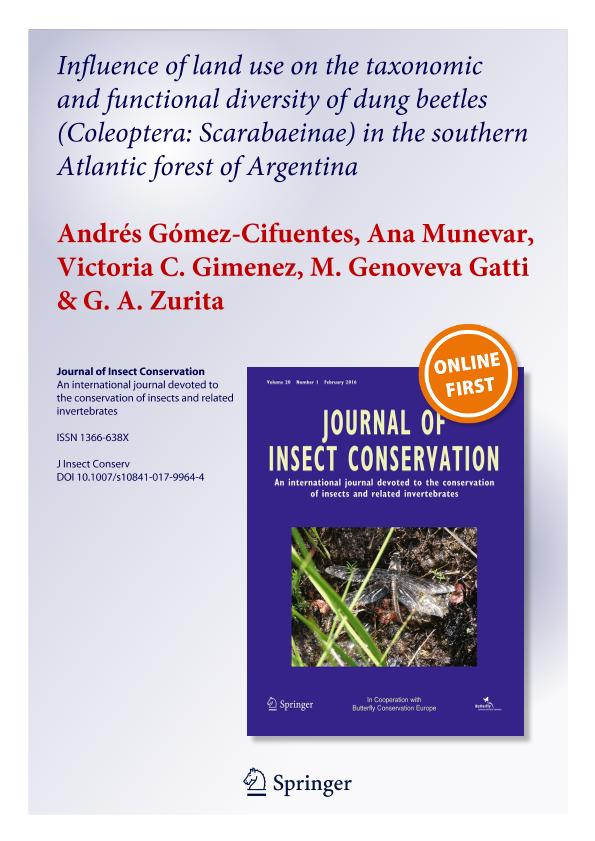Mostrar el registro sencillo del ítem
dc.contributor.author
Gomez Cifuentes, Andres Mauricio

dc.contributor.author
Munevar Lozano, Ana Katerinne

dc.contributor.author
Gimenez Gomez, Victoria Carolina

dc.contributor.author
Gatti, Maria Genoveva

dc.contributor.author
Zurita, Gustavo Andres

dc.date.available
2018-05-08T20:56:58Z
dc.date.issued
2017-03
dc.identifier.citation
Gomez Cifuentes, Andres Mauricio; Munevar Lozano, Ana Katerinne; Gimenez Gomez, Victoria Carolina; Gatti, Maria Genoveva; Zurita, Gustavo Andres; Influence of land use on the taxonomic and functional diversity of dung beetles (Coleoptera: Scarabaeinae) in the southern Atlantic forest of Argentina.; Springer; Journal of Insect Conservation; 21; 1; 3-2017; 147–156
dc.identifier.issn
1366-638X
dc.identifier.uri
http://hdl.handle.net/11336/44530
dc.description.abstract
The degradation and replacement of native ecosystems affects both their taxonomic and functional biodiversity. However, native species may find a gradient of habitat suitability in different land uses within a region. The aim of this study was to evaluate the effect of land use on the taxonomic and functional diversity of dung beetle assemblages in the southern Atlantic forest of Argentina. Dung beetles were sampled in both the native forest (control) and different land uses (Pine and Yerba mate plantations and cattle pastures) during the 2014 summer, using pitfall traps baited with human feces and rotten meat. Samplings were taken from 20 different sites, with five replicates of each land use and the native forest (100 pitfall traps in total). A total of 1699 beetles of 27 species were captured. Canthon quinquemaculatus, Canthon conformis and Dichotomius sericeus were the most abundant species. Cattle pastures were the land use most negatively affected in their taxonomic and functional diversity, particularly large paracoprid dung beetles. Pine plantations maintained their taxonomic and functional diversity in relation to the native forest and Yerba mate plantations showed, in general, an intermediate situation. Microclimatic conditions (average temperature and humidity and maximum temperature) were correlated with functional diversity (the proportion of large paracoprid dung beetles decreased with increasing temperature) and are probably good predictors to explain the observed patterns of functional diversity of dung beetles. The development of sustainable production systems that preserve the native biodiversity requires the conservation of key components from the ecological niche of native species, especially microclimatic conditions.
dc.format
application/pdf
dc.language.iso
eng
dc.publisher
Springer

dc.rights
info:eu-repo/semantics/openAccess
dc.rights.uri
https://creativecommons.org/licenses/by-nc-sa/2.5/ar/
dc.subject
Fragmentation
dc.subject
Functional Traits
dc.subject
Pastures
dc.subject
Richness
dc.subject
Subtropical Forest
dc.subject
Tree Plantations
dc.subject.classification
Otras Ciencias Biológicas

dc.subject.classification
Ciencias Biológicas

dc.subject.classification
CIENCIAS NATURALES Y EXACTAS

dc.title
Influence of land use on the taxonomic and functional diversity of dung beetles (Coleoptera: Scarabaeinae) in the southern Atlantic forest of Argentina.
dc.type
info:eu-repo/semantics/article
dc.type
info:ar-repo/semantics/artículo
dc.type
info:eu-repo/semantics/publishedVersion
dc.date.updated
2018-05-04T20:15:57Z
dc.identifier.eissn
1572-9753
dc.journal.volume
21
dc.journal.number
1
dc.journal.pagination
147–156
dc.journal.pais
Alemania

dc.journal.ciudad
Berlin
dc.description.fil
Fil: Gomez Cifuentes, Andres Mauricio. Consejo Nacional de Investigaciones Científicas y Técnicas. Centro Científico Tecnológico Conicet - Nordeste. Instituto de Biología Subtropical. Instituto de Biología Subtropical - Nodo Puerto Iguazú | Universidad Nacional de Misiones. Instituto de Biología Subtropical. Instituto de Biología Subtropical - Nodo Puerto Iguazú; Argentina
dc.description.fil
Fil: Munevar Lozano, Ana Katerinne. Consejo Nacional de Investigaciones Científicas y Técnicas. Centro Científico Tecnológico Conicet - Nordeste. Instituto de Biología Subtropical. Instituto de Biología Subtropical - Nodo Puerto Iguazú | Universidad Nacional de Misiones. Instituto de Biología Subtropical. Instituto de Biología Subtropical - Nodo Puerto Iguazú; Argentina
dc.description.fil
Fil: Gimenez Gomez, Victoria Carolina. Consejo Nacional de Investigaciones Científicas y Técnicas. Centro Científico Tecnológico Conicet - Nordeste. Instituto de Biología Subtropical. Instituto de Biología Subtropical - Nodo Puerto Iguazú | Universidad Nacional de Misiones. Instituto de Biología Subtropical. Instituto de Biología Subtropical - Nodo Puerto Iguazú; Argentina
dc.description.fil
Fil: Gatti, Maria Genoveva. Consejo Nacional de Investigaciones Científicas y Técnicas. Centro Científico Tecnológico Conicet - Nordeste. Instituto de Biología Subtropical. Instituto de Biología Subtropical - Nodo Puerto Iguazú | Universidad Nacional de Misiones. Instituto de Biología Subtropical. Instituto de Biología Subtropical - Nodo Puerto Iguazú; Argentina
dc.description.fil
Fil: Zurita, Gustavo Andres. Consejo Nacional de Investigaciones Científicas y Técnicas. Centro Científico Tecnológico Conicet - Nordeste. Instituto de Biología Subtropical. Instituto de Biología Subtropical - Nodo Puerto Iguazú | Universidad Nacional de Misiones. Instituto de Biología Subtropical. Instituto de Biología Subtropical - Nodo Puerto Iguazú; Argentina
dc.journal.title
Journal of Insect Conservation

dc.relation.alternativeid
info:eu-repo/semantics/altIdentifier/doi/http://dx.doi.org/10.1007/s10841-017-9964-4
dc.relation.alternativeid
info:eu-repo/semantics/altIdentifier/url/https://link.springer.com/article/10.1007%2Fs10841-017-9964-4
Archivos asociados
